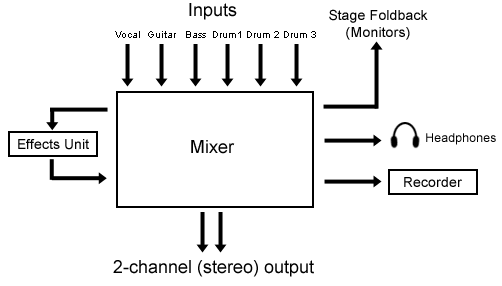Sound Mixers: Overview

A sound mixer is a device which takes two or more audio signals, mixes them together and provides one or more output signals. The diagram on the right shows a simple mixer with six inputs and two outputs.
As well as combining signals, mixers allow you to adjust levels, enhance sound with equalization and effects, create monitor feeds, record various mixes, etc.
Mixers come in a wide variety of sizes and designs, from small portable units to massive studio consoles. The term mixer can refer to any type of sound mixer; the terms sound desk and sound console refer to mixers which sit on a desk surface as in a studio setting.
Sound mixers can look very intimidating to the newbie because they have so many buttons and other controls. However, once you understand how they work you realise that many of these controls are duplicated and it's not as difficult as it first seems.
Applications
Some of the most common uses for sound mixers include:
- Music studios and live performances: Combining different instruments into a stereo master mix and additional monitoring mixes.
- Television studios: Combining sound from microphones, tape machines and other sources.
- Field shoots: Combining multiple microphones into 2 or 4 channels for easier recording.
Channels
Mixers are frequently described by the number of channels they have. For example, a "12-channel mixer" has 12 input channels, i.e. you can plug in 12 separate input sources. You might also see a specification such as "24x4x2" which means 24 input channels, 4 subgroup channels and two output channels.
More channels means more flexibility, so more channels is generally better. See mixer channels for more information.
Advanced Mixing
The diagram below shows how a mixer can provide additional outputs for monitoring, recording, etc. Even this is just scratching the surface of what advanced mixers are capable of.

Next Page: Mixer Input Channels